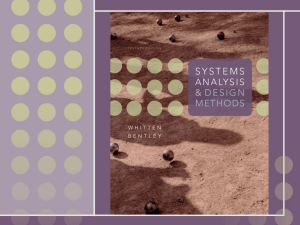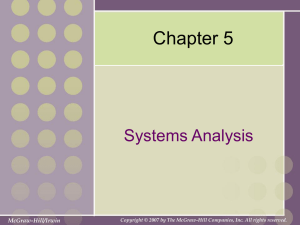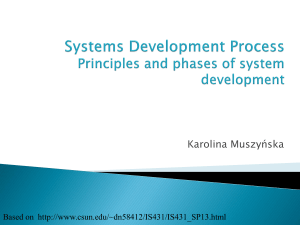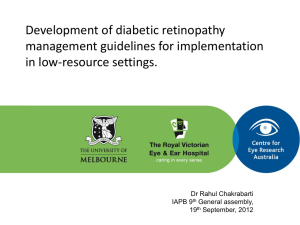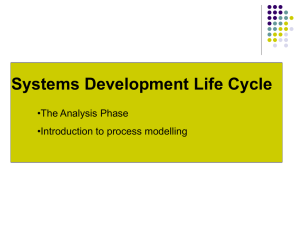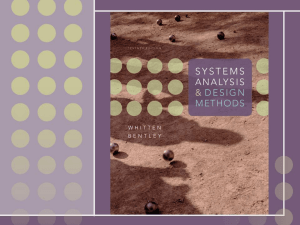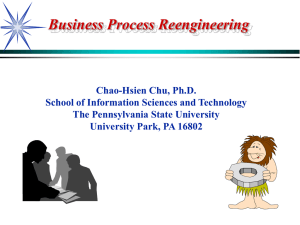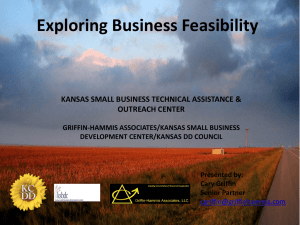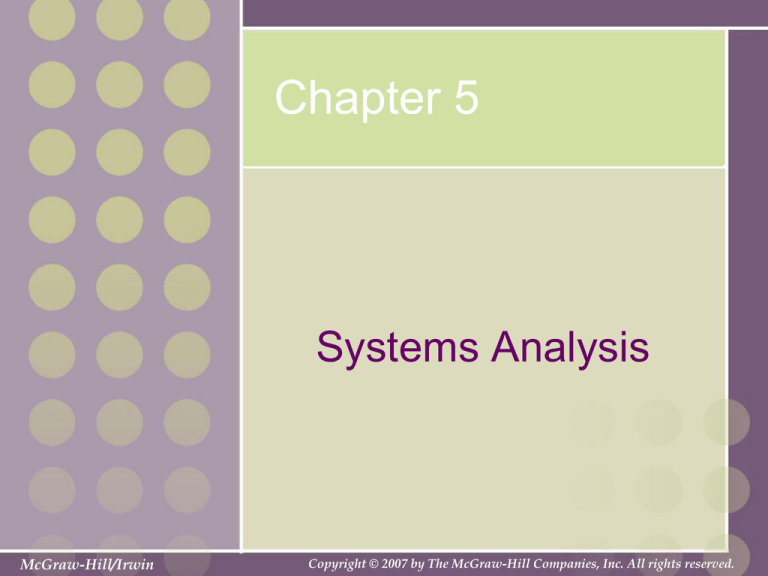
Chapter 5
Systems Analysis
McGraw-Hill/Irwin
Copyright © 2007 by The McGraw-Hill Companies, Inc. All rights reserved.
What is Systems Analysis ?
Systems analysis – a problem-solving technique that
decomposes a system into its component pieces for the
purpose of studying how well those component parts work
and interact to accomplish their purpose.
Systems design – a complementary problem-solving
technique (to systems analysis) that reassembles a system’s
component pieces back into a complete system—hopefully,
an improved system. This may involves adding, deleting, and
changing pieces relative to the original system.
5-2
Information systems analysis – those development phases
in an information systems development project the primarily
focus on the business problem and requirements, independent
of any technology that can or will be used to implement a
solution to that problem.
Systems Analysis Phases
• Scope Definition Phase
•
Is the project worth looking at?
• Problem Analysis Phase
• Is a new system worth building?
• Requirements Analysis Phase
• What do the users need and want from the new system?
• Logical Design Phase
• What must the new system do?
• Decision Analysis Phase
• What is the best solution?
5-3
Systems Analysis Phases
• Scope Definition Phase
• Is the project worth looking at?
• Problem Analysis Phase
• Is a new system worth building?
• Requirements Analysis Phase
• What do the users need and want from the new system?
• Logical Design Phase
• What must the new system do?
• Decision Analysis Phase
• What is the best solution?
5-4
Key Terms for Scope Definition
Phase
Steering body – a committee of executive business and
system managers that studies and prioritizes competing
project proposals to determine which projects will return
the most value to the organization and thus should be
approved for continues systems development.
• Also called a steering committee.
Project charter – the final deliverable for the preliminary
investigation phase. A project charter defines the project
scope, plan, methodology, standards, and so on.
• Preliminary master plan includes preliminary schedule and
resource assignments (also called a baseline plan).
• Detailed plan and schedule for completing the next phase of the
project.
5-5
Sample Request for System Services
5-6
Sample Problem Statements
5-7
Systems Analysis Phases
• Scope Definition Phase
•
Is the project worth looking at?
• Problem Analysis Phase
• Is a new system worth building?
• Requirements Analysis Phase
• What do the users need and want from the new system?
• Logical Design Phase
• What must the new system do?
• Decision Analysis Phase
• What is the best solution?
5-8
Key Terms of the
Problem Analysis Phase
Cause-and-effect analysis – a technique in which
problems are studied to determine their causes and
effects.
In practice, effects can be symptomatic of more deeply
rooted problems which, in turn, must be analyzed for
causes and effects until the causes and effects do not yield
symptoms of other problems.
5-9
Definition of Reengineering
The fundamental rethinking and radical
redesign of core business processes to
achieve dramatic improvements in critical
performance measures such as quality,
cost, and cycle time.
Source: Adapted from Hammer and Champy, Reengineering the Corporation, 1993
What Business Reengineering
Is Not?
Automating: Paving the cow paths.
(Automate poor processes.)
Downsizing: Doing less with less. Cut costs
or reduce payrolls. (Creating new
products and services, as well as positive
thinking are critical to the success of
BPR.)
Reengineering Might be ...
Obliterate what you have now and start from
scratch.
Transform every aspect of your
organization.
Source: Michael Hammer, “Reengineering Work: Don’t Automate, Obliterate,” Harvard
Business Review, July-August, 1990, pp. 104-112.
Business Process
Reengineering Life Cycle
Define corporate
visions and business
goals
Visioning
Identify business
processes to be
reengineered
Analyze and
measure an
existing process
Identifying
Analyzing
Identify enabling IT &
generate alternative
process redesigns
Redesigning
Evaluate and
select a process
redesign
Evaluating
Implement the
reengineered
process
Continuous
improvement of
the process
Implementing
Improving
Reengineering Example
Cash Lane
No more than
10 items
Which line is
shorter and
faster?
Reengineered Process
Key Concept:
• One queue for
multiple service
points
• Multiple services
workstation
Insurance Policy Process Before
Reengineering
....
Department A
Step 1
Department A
Step 2
Issuance
Application
Issuance
Policy
Department E
Step 19
19 steps, 5 departments, 19 persons
Issuance application processing cycle time: 24 hours
minimum; average 22 days
But: only 17 minutes in actually processing the application!
*Source: Adapted from Rethinking the Corporate Workplace: Case Manager at Mutual
Benefit Life, Harvard Business School case 9-492-015, 1991.
Insurance Policy Process After
Reengineering
Mainframe
Physician
Underwriter
LAN
Server
Case Manager
PC
Workstation
• application processing cycle time: 4
hours minimum; 3.5 days average
• application handling capacity doubled
• cut 100 field office positions
Criteria for BPR Projects
Improvement Goals
Status Quo
Radical
Cross Function/
Organization
Fundamental
Business
Reengineering
Scope
Role
of IT
Functional
Process
Improvement
Function
Business
as Usual
Incidental
Task
Symbolic
Intense
Senior Management Involvement
Cause-and-Effect (POOC) Analysis
5-19
What are the Problems?
You need to:
• Solicit input
• Identify problems that currently exist, have been
experienced in the past and are expected to
recur, or could occur in the future
• Identify the conditions under which these
problems occur
• Prioritize the problems identified
Problems typically identify some existing
condition, along with a desired future state.
Problem Analysis - 1
Goals are often very general concepts, e.g.
• Efficiency, Quality, Fairness, Health, Happiness, …
Objectives are operational definitions of goals; a
measure of success. It is something that you expect to
achieve, given sufficient resources.
• Reduce the number of uncollectible customer accounts by 50
percent within the next year.
• Increase by 25 percent the number of loan applications that
can be processed during an eight-hour shift.
• Decrease by 50 percent the time required to reschedule a
production lot when a workstation malfunctions.
5-21
Problem Analysis - 2.
Constraint – something that will limit your flexibility in
defining a solution to your objectives. Constraints are
requirements that you cannot change, e.g.
• The new system must be operational by April 15.
• The new system cannot cost more than $350,000.
• The new system must interact with our suppliers’ systems, using
their predefined protocols.
• The new system must bill customers every 15 days.
Three types of constraints
• Natural - bound by the laws of nature
• External - enforced by outside agents
• Perceived - assumed to be undesirable, prohibited or impossible
Sometimes you need to challenge constraints.
5-22
System Improvement Report
Outline
I. Executive summary (approximately 2 pages)
A.
B.
C.
D.
Summary of recommendation
Summary of problems, opportunities, and directives
Brief statement of system improvement objectives
Brief explanation of report contents
II. Background information (approximately 2 pages)
A. List of interviews and facilitated group meetings conducted
B. List of other sources of information that were exploited
C. Description of analytical techniques used
III. Overview of current system (approximately 5 pages)
A. Strategic implications (if project is part of or impacts
existing IS strategic plan)
B. Models of the current system
5-23
1. Interface model (showing project scope)
2. Data model (showing project scope)
3. Geographical models (showing project scope)
4. Process model (showing functional decomposition only)
System Improvement Report
Outline (cont.)
I. Analysis of the current system (approx. 5-10 pages)
A.
B.
C.
D.
E.
F.
Performance problems, opportunities, cause-effect analysis
Information problems, opportunities, cause-effect analysis
Economic problems, opportunities, cause-effect analysis
Control problems, opportunities, cause-effect analysis
Efficiency problems, opportunities, cause-effect analysis
Service problems, opportunities, and cause-effect analysis
II. Detailed recommendations (approx. 5-10 pages)
A. System improvement objectives and priorities
B. Constraints
C. Project Plan
1. Scope reassessment and refinement
2. Revised master plan
3. Detailed plan for the definition phase
III. Appendixes
5-24
A. Any detailed system models
B. Other documents as appropriate
Group Exercise
• Create a Cause-and-Effect (POOC) analysis and
matrix for your group project.
• Due: via email to the Professor before next class
meeting
5-25
Systems Analysis Phases
• Scope Definition Phase
•
Is the project worth looking at?
• Problem Analysis Phase
• Is a new system worth building?
• Requirements Analysis Phase
• What do the users need and want from
the new system?
• Logical Design Phase
• What must the new system do?
• Decision Analysis Phase
• What is the best solution?
5-26
Key Terms of
Requirements Analysis Phase
Functional requirement – a description of
activities and services a system must provide.
• inputs, outputs, processes, stored data
Nonfunctional/quality requirement – a
description of other characteristics that define a
satisfactory system
• Performance, ease of learning and use, budgets,
deadlines, documentation, security, internal
auditing controls
5-27
Key Terms of Requirements
Analysis Phase (cont.)
Use case – a business scenario or event for
which the system must provide a defined
response. Use cases evolved out of objectoriented analysis; however, their use has
become common in many other methodologies
for systems analysis and design.
5-28
Key Terms of Requirements
Analysis Phase (cont.)
Timeboxing – a technique that delivers information
systems functionality and requirements through
versioning.
1. The development team selects the smallest subset of the system
that, if fully implemented, will return immediate value to the
systems owners and users.
2. That subset is developed, ideally with a time frame of six to nine
months or less.
3. Subsequently, value-added versions of the system are
developed in similar time frames.
•
•
5-29
A mandatory requirement is one that must be fulfilled by the
minimal system, version 1.0
A desirable requirement is one that is not absolutely essential to
version 1.0. It may be essential to the vision of a future version.
Requirements Discovery
Requirements discovery – the process,
used by systems analysts of identifying or
extracting system problems and solution
requirements from the user community.
5-30
The World of Requirements
Requirements Discovery
Methods
• Fact-finding – the process of collecting information about
system problems, opportunities, solution requirements, and
priorities.
•
•
•
•
•
Sampling existing documentation, reports, forms, databases, etc
Research of relevant literature
Observation of the current system
Questionnaires and surveys
Interviews
• Joint requirements planning (JRP) –use of facilitated
workshops to bring together all of the system owners, users,
and analysts, and some systems designer and builders to
jointly perform systems analysis.
• Considered a part of a larger method called joint application
development (JAD), a more comprehensive application of the
JRP techniques to the entire systems development process.
5-32
Systems Analysis Phases
• Scope Definition Phase
•
Is the project worth looking at?
• Problem Analysis Phase
• Is a new system worth building?
• Requirements Analysis Phase
• What do the users need and want from the new system?
• Logical Design Phase
• What must the new system do?
• Decision Analysis Phase
• What is the best solution?
5-33
Model-Driven Analysis Methods
Model-driven analysis – a problem-solving approach that
emphasizes the drawing of pictorial system models to
document and validate both existing and/or proposed
systems. Ultimately, the system model becomes the blueprint
for designing and constructing an improved system.
Model – a representation of either reality or vision. Since “a
picture is worth a thousand words,” most models use
pictures to represent the reality or vision.
5-34
Model-Driven Approaches
• Traditional Approaches
• Structured Analysis
• Focuses on the flow of data through processes
• Key model: data flow diagram
• Information Engineering
• Focuses on structure of stored data
• Key model: entity relationship diagram
• Object-Oriented Approach
• integrates data and process concerns into objects
• Object – the encapsulation of the data (called properties) that
describes a discrete person, object, place, event, or thing, with
all the processes (called methods) that are allowed to use or
update the data and properties. The only way to access or
update the object’s data is to use the predefined processes.
• Key model: Unified Modeling Language (UML) diagrams
5-35
A Simple Process Model
5-36
A Simple Data Model
5-37
A Simple Object Model
5-38
Accelerated Systems Analysis
Accelerated systems analysis
approaches emphasize the construction
of prototypes to more rapidly identify
business and user requirements for a
new system.
Prototype – a small-scale, incomplete,
but working sample of a desired system.
• Accelerated systems analysis approaches
• Discovery Prototyping
• Rapid Architected Analysis
5-39
Discovery Prototyping
Discovery prototyping – identify the
users’ business requirements by having
them react to a quick-and-dirty
implementation of those requirements.
• Advantages
• Prototypes cater to the “I’ll know what I want when I see it” way of
thinking that is characteristic of many users and managers.
• Disadvantages
• Can become preoccupied with final “look and feel” prematurely
• Can encourage a premature focus on, and commitment to, design
• Users can be misled to believe that the completed system can be
built rapidly using prototyping tools
5-40
Types of Diagrams
Data flow diagrams (DFDs) show the flow of data from
external entities into the system, how the data moves
from one process to another, as well as logical storage.
Context Diagram
A (DFD) of the scope of an organizational system that
shows the system boundaries, external entities that
interact with the system and the major information flows
between the entities and the system.
Level-O Diagram
A data flow diagram (DFD) that represents a system’s
major processes, data flows and data stores at a high
level of detail.
DFD Notation
Rectangles are external entities:
sources or destinations of data.
Rounded rectangles are processes,
which take data as input, do
something to it, and output it.
Arrows are the data flows, which can
either be electronic data or physical.
Open-ended rectangles are data
stores, including databases or XML
files, as well as physical stores such
as or filing cabinets.
New customer
1
Add
Customer
Packing slip
D Customer
1 Master
Context Diagram
8.43
Level-0 DFD
8.44
Example Context Diagram for an
Order Processing System
New customer
Order
Customer
Invoice
Ship
Statement
Picking Slip
Order
System
Order
Warehouse
DFD for Order Entry
1
New customer
New
info
D Customer
1 Master
Add
Customer
2
Customer
Order
Process
Customer
Order
Cust Info
Pending
Order
Backorder
D Back
3 Order
3
Warehouse
Picking
Slip
Produced
Packing
slip
Warehouse
Order
Picked
4
Proc
Info
D Inventory
2 Master
Ship N/A
D Customer
1 Master
Shipping
Prepare
Ship
statement
Shipping B/O info
5
Cust Bill
Bill N/A
Bill Info
Customer
Bill
Produce
Customer
Breakdown of 2 (Process
Customer Order)
Order
Customer
Need to
establish
2.1
D Customer
1 Master
Verify
Customer
Valid
2.2
Customer
D Inventory
2 Master
Order
Notify
Verify
Item
Update
2.4
Valid
Item
Avail
2.3
Check
Available
Update
Commit
D Shipping
4 Taxes
Tax
2.5
Back
Order
D Back
3 Order
Create
Order
Ord D Inventory
2 Master
Pending
Order
Systems Analysis Phases
• Scope Definition Phase
•
Is the project worth looking at?
• Problem Analysis Phase
• Is a new system worth building?
• Requirements Analysis Phase
• What do the users need and want from the new system?
• Logical Design Phase
• What must the new system do?
• Decision Analysis Phase
• What is the best solution?
5-48
Key Terms of Decision Analysis
Phase
• Technical feasibility – Is the solution technically
practical? Does our staff have the technical expertise
to design and build this solution?
• Operational feasibility – Will the solution fulfill the
users’ requirements? To what degree? How will the
solution change the users’ work environment? How do
users feel about such a solution?
• Economic feasibility – Is the solution cost-effective?
• Schedule feasibility – Can the solution be designed
and implemented within an acceptable time period?
5-49
Candidate Systems Matrix
5-50
Candidate Systems Matrix
(cont.)
5-51
Feasibility Analysis Matrix - 1
This matrix complements the candidate
systems matrix with an analysis and ranking
of the candidate systems.
• The columns of the matrix correspond to the
same candidate solutions as shown in the
candidate systems matrix.
• Some rows correspond to the feasibility criteria
already discussed (e.g. cost, schedule).
• Rows are added to describe the general solution
and a ranking of the candidates.
• The cells contain the feasibility assessment
notes for each candidate.
Feasibility Analysis Matrix - 2
Each row is assigned a weight for each
criterion.
Each candidate is scored for each criterion.
After scoring all candidates on all criteria, a
final score is recorded in the last row.
Feasibility Analysis Matrix - 3.
5-54
Typical System Proposal
Outline
I.
II.
5-55
III.
IV.
V.
VI.
Introduction
A. Purpose of the report
B. Background of the project leading to this report
C. Scope of the report
D. Structure of the report
Tools and techniques used
A. Solution generated
B. Feasibility analysis (cost-benefit)
Information systems requirements
Alternative solutions and feasibility analysis
Recommendations
Appendices
Group Exercise
• Create a Feasibility analysis and matrix for your
group project.
• Decide on your chosen approach and justify why it
is a reasonable one, e.g.:
• What are the improvement objectives and priorities?
• How does your approach meet these objectives?
• What other approaches were considered and why were
they rejected?
• Due: before next class meeting
5-56

